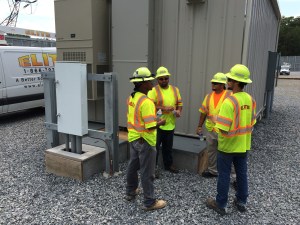“The Ripple Effect”
Most safety professionals like to cover the consequences of an accident and while it is important to understand the initial consequences of an accident, we could be better served to view the aftermath of an accident in terms of the ripple effect. Just like the ripples that a rock creates skipping across the pond, so do the actions and choices we make at work.
Let’s look at a hypothetical situation. While working on a project John has to access the roof of a single story building. The roof he is accessing is flat and the area where John is working is in the middle of the roof, so there is no need for him to have on fall protection. However, as John completes his work the project changes. These changes will now require John to work right next to the leading edge of the roof where there is little more than a 24” knee wall. Now John knows he needs fall protection, he has been trained on when the equipment is necessary and how to properly setup and wear the personal protection equipment (PPE). Instead of taking the time to wear and setup his PPE he makes a choice to forgo the necessary PPE.
While completing his work John slips and falls from the roof landing on his back. This is the first ripple for his choice. John’s choice to not wear his PPE has resulted in him being injured. Now we start to see more ripples as the employees working in the area drop there tools and immediately rush over to help John. John’s poor choice has not only resulted in him being injured but has also stopped all productivity at the jobsite.
At this point there are two roads we are going to travel down. On the first road we are going to look at the ripples that could affect John personally. Then we are going to go down the second road and see how the ripples effect everyone else at the company.
The good news for John is that he is going to survive his accident. The bad news is his recovery is going to take a couple of months. Let’s say that John is out of work and is talking with the insurance company about workers compensation and they decide that because he made the choice of not using his PPE the insurance company has denied his claim. If this happens then John will not receive any compensation while he is out of work, but he will also be personally responsible for his medical bills. This takes an effect of John financially, he is not able to cover his bills and he is out of work. This could also take an effect on him emotionally because of the lack of income and the bills coming in. John’s choice had greater consequences than he originally thought.
John’s employer and his co-workers will all be affected by the accident as well. John’s accident consumed valuable company resources and this is the first ripple that affects the company it can be a rather large one. The time that the project was shut down due the accident can never be recovered. To add to this loss of time an investigation into why John’s accident occurred must be completed. This investigation will require more man hours to be lost while employees are giving a statement on the accident.
Since John is out of work now his employer is going to have no choice but to pay overtime to their employees to make up for being a man short. This will cost his employer even more money by paying overtime rates and spending more time on the job than projected. Still these ripples are just the first ones to reach the company. In the long term ripples from this accident will affect the company’s safety record, their insurance rates and their ability to be the successful bidder on future projects. This could lead to not only less profit for the company but layoffs of employees.
The ripples from John’s accident could not only affected him, but his co-workers and employer. This is why as a Company it is not only important to establish a safety program but to establish a safety cultural. Employees need to be empowered to stop work when they feel it is unsafe. Employees must be recognized when they take the time to complete the task in a safe manner. Workers must be willing to talk with their co-workers/employer when they observe them engaging in unsafe practices.
It is preciously because of these benefits that Elite’s Management team is not only willing to but encourages feedback from our teams in the field. Our Management team never wants an employee to think that it is acceptable to forgo utilizing any piece of safety equipment to save a little bit of time. It is this commitment to safety that leads to our constant improvement in our safety culture.
SAFETY ALWAYS

 chili. However, there is one change that fall brings with it that many of us may not have thought about quite yet. During the fall is when the largest number of DVCs, aka deer-vehicle collisions occurs. In order to protect both wildlife and ourselves we must first recognize the seriousness of this hazard in which we face.
chili. However, there is one change that fall brings with it that many of us may not have thought about quite yet. During the fall is when the largest number of DVCs, aka deer-vehicle collisions occurs. In order to protect both wildlife and ourselves we must first recognize the seriousness of this hazard in which we face.